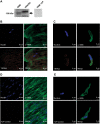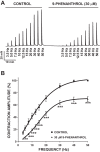Novel regulatory mechanism in human urinary bladder: central role of transient receptor potential melastatin 4 channels in detrusor smooth muscle function
- PMID: 26791488
- PMCID: PMC4824161
- DOI: 10.1152/ajpcell.00270.2015
Novel regulatory mechanism in human urinary bladder: central role of transient receptor potential melastatin 4 channels in detrusor smooth muscle function
Abstract
Transient receptor potential melastatin 4 (TRPM4) channels are Ca(2+)-activated nonselective cation channels that have been recently identified as regulators of detrusor smooth muscle (DSM) function in rodents. However, their expression and function in human DSM remain unexplored. We provide insights into the functional role of TRPM4 channels in human DSM under physiological conditions. We used a multidisciplinary experimental approach, including RT-PCR, Western blotting, immunohistochemistry and immunocytochemistry, patch-clamp electrophysiology, and functional studies of DSM contractility. DSM samples were obtained from patients without preoperative overactive bladder symptoms. RT-PCR detected mRNA transcripts for TRPM4 channels in human DSM whole tissue and freshly isolated single cells. Western blotting and immunohistochemistry with confocal microscopy revealed TRPM4 protein expression in human DSM. Immunocytochemistry further detected TRPM4 protein expression in DSM single cells. Patch-clamp experiments showed that 9-phenanthrol, a selective TRPM4 channel inhibitor, significantly decreased the transient inward cation currents and voltage step-induced whole cell currents in freshly isolated human DSM cells. In current-clamp mode, 9-phenanthrol hyperpolarized the human DSM cell membrane potential. Furthermore, 9-phenanthrol attenuated the spontaneous phasic, carbachol-induced and nerve-evoked contractions in human DSM isolated strips. Significant species-related differences in TRPM4 channel activity between human, rat, and guinea pig DSM were revealed, suggesting a more prominent physiological role for the TRPM4 channel in the regulation of DSM function in humans than in rodents. In conclusion, TRPM4 channels regulate human DSM excitability and contractility and are critical determinants of human urinary bladder function. Thus, TRPM4 channels could represent promising novel targets for the pharmacological or genetic control of overactive bladder.
Keywords: 9-phenanthrol; patch-clamp electrophysiology; smooth muscle; transient receptor potential channels; urinary bladder.
Copyright © 2016 the American Physiological Society.
Figures










Comment in
-
New life in overactive bladder. Focus on "Novel regulatory mechanism in human urinary bladder: central role of transient receptor potential melastatin 4 channels in detrusor smooth muscle function".Am J Physiol Cell Physiol. 2016 Apr 1;310(7):C597-9. doi: 10.1152/ajpcell.00039.2016. Epub 2016 Feb 17. Am J Physiol Cell Physiol. 2016. PMID: 26888821 Free PMC article. No abstract available.
Similar articles
-
TRPM4 channel inhibitors 9-phenanthrol and glibenclamide differentially decrease guinea pig detrusor smooth muscle whole-cell cation currents and phasic contractions.Am J Physiol Cell Physiol. 2020 Feb 1;318(2):C406-C421. doi: 10.1152/ajpcell.00055.2019. Epub 2019 Dec 18. Am J Physiol Cell Physiol. 2020. PMID: 31851526 Free PMC article.
-
Novel role for the transient potential receptor melastatin 4 channel in guinea pig detrusor smooth muscle physiology.Am J Physiol Cell Physiol. 2013 Mar 1;304(5):C467-77. doi: 10.1152/ajpcell.00169.2012. Epub 2013 Jan 9. Am J Physiol Cell Physiol. 2013. PMID: 23302778 Free PMC article.
-
TRPM4 channel: a new player in urinary bladder smooth muscle function in rats.Am J Physiol Renal Physiol. 2013 Apr 1;304(7):F918-29. doi: 10.1152/ajprenal.00417.2012. Epub 2013 Jan 2. Am J Physiol Renal Physiol. 2013. PMID: 23283997 Free PMC article.
-
Role of potassium ion channels in detrusor smooth muscle function and dysfunction.Nat Rev Urol. 2011 Dec 13;9(1):30-40. doi: 10.1038/nrurol.2011.194. Nat Rev Urol. 2011. PMID: 22158596 Free PMC article. Review.
-
The TRPM4 channel inhibitor 9-phenanthrol.Br J Pharmacol. 2014 Apr;171(7):1600-13. doi: 10.1111/bph.12582. Br J Pharmacol. 2014. PMID: 24433510 Free PMC article. Review.
Cited by
-
TRP Channels as Lower Urinary Tract Sensory Targets.Med Sci (Basel). 2019 May 22;7(5):67. doi: 10.3390/medsci7050067. Med Sci (Basel). 2019. PMID: 31121962 Free PMC article. Review.
-
Detrusor Smooth Muscle KV7 Channels: Emerging New Regulators of Urinary Bladder Function.Front Physiol. 2020 Sep 16;11:1004. doi: 10.3389/fphys.2020.01004. eCollection 2020. Front Physiol. 2020. PMID: 33041840 Free PMC article. Review.
-
Pharmacological Modulation and (Patho)Physiological Roles of TRPM4 Channel-Part 2: TRPM4 in Health and Disease.Pharmaceuticals (Basel). 2021 Dec 28;15(1):40. doi: 10.3390/ph15010040. Pharmaceuticals (Basel). 2021. PMID: 35056097 Free PMC article. Review.
-
Differential effects of TRPM4 channel inhibitors on Guinea pig urinary bladder smooth muscle excitability and contractility: Novel 4-chloro-2-[2-(2-chloro-phenoxy)-acetylamino]-benzoic acid (CBA) versus classical 9-phenanthrol.Pharmacol Res Perspect. 2022 Aug;10(4):e00982. doi: 10.1002/prp2.982. Pharmacol Res Perspect. 2022. PMID: 35822549 Free PMC article.
-
New life in overactive bladder. Focus on "Novel regulatory mechanism in human urinary bladder: central role of transient receptor potential melastatin 4 channels in detrusor smooth muscle function".Am J Physiol Cell Physiol. 2016 Apr 1;310(7):C597-9. doi: 10.1152/ajpcell.00039.2016. Epub 2016 Feb 17. Am J Physiol Cell Physiol. 2016. PMID: 26888821 Free PMC article. No abstract available.
References
-
- Andersson KE, Arner A. Urinary bladder contraction and relaxation: physiology and pathophysiology. Physiol Rev 84: 935–986, 2004. - PubMed
-
- Armstrong RB, Dmochowski RR, Sand PK, MacDiarmid S. Safety and tolerability of extended-release oxybutynin once daily in urinary incontinence: combined results from two phase 4 controlled clinical trials. Int Urol Nephrol 39: 1069–1077, 2007. - PubMed
Publication types
MeSH terms
Substances
Grants and funding
LinkOut - more resources
Full Text Sources
Other Literature Sources
Miscellaneous

